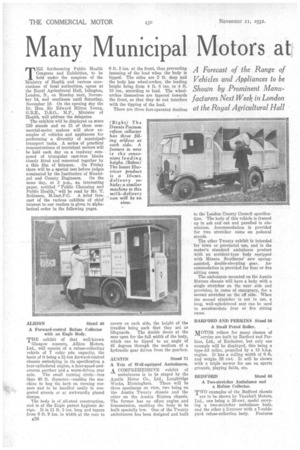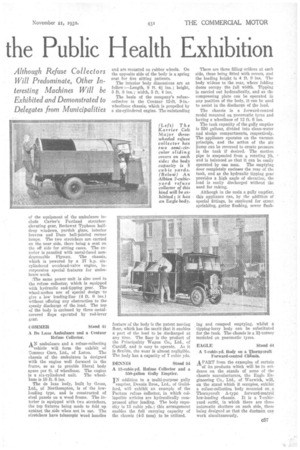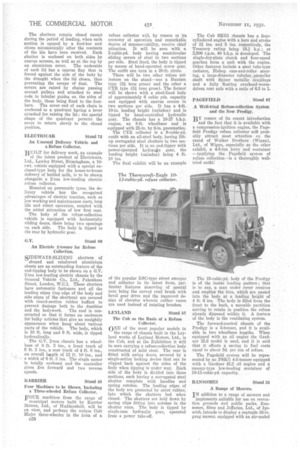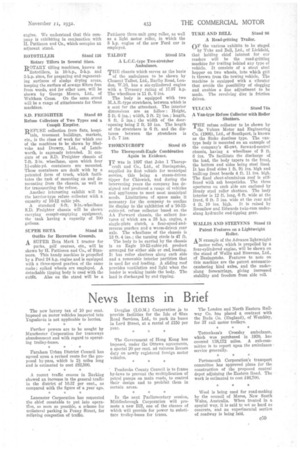Many Municipal Motors at the Public Health Exhibition
Page 98

Page 99

Page 100

Page 101

If you've noticed an error in this article please click here to report it so we can fix it.
A Forecast of the Range of Vehicles and Appliances to be Shown by Prominent Manufacturers Next Week in London at the Royal Agricultural Hall Although Refuse Collectors Will Predominate, Other Interesting Machines Will be Exhibited and Demonstrated to Delegates from Municipalities
THE forthcoming Public Health Congress and Exhibition, to be held under the auspices of the Ministry of Health and various associations of local authorities, opens at the Royal Agricultural Hall, Islington, London, N., on Monday next, November 14, and continues until Saturday, November 19. On the opening day the Rt. Hon. Sir Edward Hilton Young, G.B.E., D.S.O., M.P., Minister of Health, will address the delegates.
The exhibits will be displayed on some 150 stands and on 21 of them commercial-motor makers will show examples of vehicles and appliances for performing a diversity of municipaltransport tasks. A series of practical demonstrations of municipal motors will be held each day on a roadway composed of triangular east-iron blocks closely fitted and cemented together by a thin film of bitumen. On Friday there will be a special test before judges nominated by the Institution of Municipal and County Engineers. On the setae day, at 3 p.m., an interesting• paper, entitled "Public Cleansing and Public Health," will be read by Mr. T. Robinson, M.Inst.P.C. A brief forecast of the various exhibits of chief interest to our readers is given in alphabetical order in the following pages.
A Forward-control Refuse Collector with an Eagle Body.
THE exhibit of that well-known
Glasgow concern, Albion Motors, Ltd., will consist of a refuse-collecting vehicle of 7 cubic yds. capacity, the basis of it being a 2i-ton forward-control chassis embodying in its specification a four-cylindered engine, a four-speed-andreverse gearbox and a worm-driven rear axle. The small turning circle—less than 40 ft. diameter—enabIes the machine to hug the kerb on turning corners and to be handled easily in congested streets or at awkwardly placed dumps.
The body is of all-steel construction, and is of the Eagle patent hygienic design. It is 11 ft. 3 ins, long and tapers from 6 ft. 9 ins. in width at the rear to
6 ft. 3 ins, at the front, thus preventing jamming of the load when the body is tipped. The sides are 2 ft. deep and the body has wheel-arches, the loading height being from 4 ft. 8 ins. to 4 ft. 10 ins., according to load. The wheelarches themselves are tapered towards the front, so that they do not interfere with the tipping of the load.
There are three foot-operated dustless covers ou each side, the height of the treadles being such that they act as lifeguards. The double doors at the rear open for the full width of the body, which can be tipped to an angle of 45 degrees through the medium of a hydraulic gear driven from the gearbox.
AUSTIN Stand 71
A Trio of Well-equipped Ambulances. A COMPREHENSIVE exhibit of
ambulances is to be staged by the Austin Motor Co., Ltd., Longbridge Works, Birmingham. There will be three specimens on view, two being on the Austin Twenty chassis and the other on the Austin Sixteen chassis. The former has an offset engine and transmission, enabling the body to be built specially low. One of the Twenty ambulances has been designed and built to the' London County"Council specification. The body of this vehicle is framed up in ash and oak and panelled in aluminium. Accommodation is provided for two stretcher cases on pedestal stands.
The other Twenty exhibit is intended for town or provincial use, and is the maker's standard ambulance product with an accident-type body equipped with Messrs. Southerns' new springassisted, double-elevating gear. Accommodation is provided for four or five sitting cases.
The ambulance mounted on th Austin Sixteen chassis will have a body with a single stretcher on the near side and provision, in cases of emergency, for a second stretcher on the off side. When the second stretcher is not in use, a long, well-upholstered seat can be used to accommodate four or five sitting cases.
BARFORD AND PERKINS Stand 58 A Small Petrol Roller.
1‘10TO1t rollers for many classes of service are built by Barford and Perkins, Ltd., of Rochester, but only one example will be displayed, this being a type-A3 roller, propelled by a 13 b.h.p. engine. It has a rolling, width of 6 ft. and weighs 39 cwt. It will be shown with a triple mower for use on sports grounds, playing fields, etc.
BEDFORD Stand 66 A Two-stretcher Ambulance and a Refuse Collector.
TWO examples of the Bedford chassis are to be shown by Vauxhall Motors, Ltd., one being a 30-cwt. model carrying a two-stretcher ambulance body, and the other a 2-tonner with a 7-cubic yard refuse-collection body. Features of the equipment of the ambulance include Carter's Portland stretcherelevating gear, Beclawat Typhoon halfdrop windows, purdah glass, interior louvres and Duco ball-jointed corner lamps. The two stretchers are carried on the near side, there being a seat on the off side for sitting cases. The exterior is panelled with metal-faced nondrumniable Plyrnax. The chassis, which is powered by a 27 h.p. sixcylindered overhead-valve engine, incorporates special features for ambitlance work.
%.The same power unit is also used in the refuse collector, which is equipped with hydraulic end-tipping gear. The wheel-arches are of special design to give a low loading-line (4 ft. ti ins.) without offering any obstruction to the speedy discharge of the load. The toll of the body is enclosed by three metalcovered flaps operated by rod-lever gear.
C OMMER Stand 41 A De Luxe Ambulance and a Centaur Refuse Collector.
AN ambulance and a refuse-collecting vehicle will form the exhibit of 13oramer Cars, Ltd., of Luton. The chassis of the ambulance is designed with the engine well forward in the frame, so as to provide liberal body space per ft. of wheelbase. The engine
is a six-cylindered unit. The wheelbase is 10 ft. 6 ins.
The de luxe body, built by Grose, Ltd., of Northampton, is of the lowloading type, and is constructed of steel panels on a wood frame. The interior is equipped with two stretchers, the top fixtures being made to fold up against the side when not in use. The stretchers have telescopic iivood handles and are mounted on rubber wheels. On the opposite side of the body is a spring seat for five sitting patients.
The interior body dimensions are as follow :—Length, 8 ft. 4/ ins.; height, 5 ft. 8 ins.; width, 5 ft. 4 ins.
The basis of the company's refusecollector is the Centaur 12-ft. 9-in.wheelbase chassis, which is propelled by a six-cylindered engine. The outstanding feature of the body is the patent moving floor, which has the merit that it enables a part of the load to be discharged at any time. The floor is the product of the Principality Wagon Co., Ltd., of Cardiff, and is easy to operate. As it is flexible, the wear is almost negligible. The body has a capacity of 7 cubic yds.
DENNIS Stand 54 A 13-cubic-yd. Refuse Collector and a 550-gallon Gully Emptier.
IN addition to a multi-purpose golly
emptier, Dennis Bros., Ltd., of Guildford, will exhibit an example of the Paeturn refuse Collector, in which collapsible articles are hydraulically compressed after loading. The body capacity is 13 cubic yds.; this arrangement enables the full carrying capacity of the chassis (4-5 tons) to be utilized.
There are three filling orifices at each side, these being fitted with covers, and the loading height is 4 ft. 9 ins. The body widens to the rear, where folding doors occupy the full width. Tippilr, is carried out hydraulically, and as thZ: compressing plate can be operated in any position of the body, it can be used to assist in the discharge of the load.
The chassis is a forward-control model mounted on pneumatic tyres and having a wheelbase of 12 ft. 6 ins.
The tank capacity of the gully emptier is 550 gallons, divided into clean-water and sludge compartments, respectively. The appliance operates on the vacuum principle, and the action of the air limp can be reversed to create pressure in the tank if desired. The suction pipe is suspended from a rotating jib, and is balanced so that it can be easily operated by one man. The emptying door completely encloses the rear of the tank, and as the hydraulic tipping gear provides a high angle of elevation, the load is easily discharged without the need for raking.
Although in the main a gully emptier, this appliance can, by the addition of special fittings, be employed for street sprinkling, gutter flushing, sewer flush lug and cesspool emptying, whilst a tipping-lorry body can be substituted for the tank. The chassis is a 21-tormer mounted on pneumatic tyres.
EAGLE Stand 44
A 7-cubic-yd. Body on a Thornycroft Forward-control Chassis.
APART from the examples of certain
of its products which will be in evidence on the stands of some of the chassis manufacturers, the Eagle Engineering Co., Ltd., of Warwick, will, on the stand which it occupies, exhibit a refuse-collection body mounted on a Tharnycroft A-typo forward-control low-loading chassis. It is a 7-cubicyard outfit, in which there are three automatic shutters on each side, these being designed so that the dustmen can work simultaneously.
The shutters remain closed except during the period of loading, when each section is opened by a foot-bar and closes automatieplly after the contents of the bin have been received. Each shutter is enclosed on both sides by canvas screens, as well as at the top by an aluminium cover. The underside of each lid has a canvas flap that is forced against the side of the body by the draught when the lid closes, thus preventing the escape of dust. The covers are raised by chains passing around pulleys and attached to steel rods in tubular guides on the sides of the body, these being fixed to the footbars. The cover end of each chain is anchored to a quadrant having a lever attached for raising the lid ; the special shape of the quadrant permits the cover to return slowly to the closed position.
ELECTRI CAR Stand 72 An Unusual Delivery Vehicle and a Refuse Collector.
BUILT for delivery work, an example of the latest product of Eiectricars, Ltd., Lawley Street, Birmingham, a 10cwt. vehicle equipped with a special enclosed-type body for the house-to-house delivery of bottled milk, is to be shown alongside a 2-ton low-loading electric refuse collector.
Mounted on pneumatic tyres, the delivery vehicle has the recognized advantages of electric traction, such as low working and maintenance costs, long life and silent operation, coupled with the added attraction of low first cost.
The body of the refuse-collection vehicle is equipped with horizontally -sliding doors, there being two openings on each side. The body is tipped to the rear by hydraulic gear.
G.V. Stand 69 An Electric 2-tonner for Refuse Collection.
SIDEWAYS-SLIDING shutters of shaped and reinforced aluminium sheets are an outstanding feature of the end-tipping body to be shown on a G.V. 2-ton low-loading electric chassis by the General Vehicle Co., Ltd., Pakenham Street, London, W.C.1. These shutters have automatic fasteners and all the loading edges (top edge of the body and side edges of the shutters) are covered with round-section rubber buffer d to prevent daniage both to the dustbins and the bodywork. The roof is constructed so that it forms an enclosure for bulky articles that give an unsightly appearance when hung about various parts of the vehicle. The body, which is 10 ft. long and 6 ft. wide, is tipped hydraulically.
The G.V. 2-ton chassis has a wheelbase of 8 ft. 3 ins., a front track of 5 ft. 3 ins., a rear track of 4 ft. 8 ins., an overall laingth of 12 ft. 10 ins., and a width of 6 ft. 3 ins. The single motor is totally enclosed and the controller gives five forward and two reverse speeds.
HARRIER Stand 43 Four Machines to be Shown, Including a Three-wheeled Refuse Collector.
FOUR machines from the range of
municipal motors built by Karrier Motors, Ltd., of Huddersfield, will be on view, and perhaps the unique Colt Major three-wheeler in the form of a C58 refuse collector will, by reason of its economy of operation and remarkable degree of manceuvrability, receive chief attention. It will be seen with a 5-cubic-yd. body having semicircular sliding covers of steel in two sections per side. Steel lined, the body is tipped by means of hand-operated screw gear. The outfit can turn in a 20-ft. circle.
There will be two other refuse collectors on the stand—one a Bantam type (2i tons gross) and the other a CYR type (31 tons gross). The former will be shown with a steel-lined body of approximately 6 cubic yds. capacity and equipped with canvas covers in two sections per side. It has a 4-ft. 10-in, loading height (unladen) and is tipped by hand-controlled hydraulic gear. The chassis has a 10-27 blip. engine, an 8-ft. wheelbase and is equipped with 25-in. by 6-in. pneumatics.
The CYR collector is a 9-cubic-yd. outfit with an all-steel body, having lif tup corrugated steel shutters in two sections per side. It is an end-tipper with power-operated hydraulic gear, the loading height (unladen) being 4 ft. 10 ins.
The final exhibit will be an example of the popular RSC-type street sweeper and collector in its latest form, particular features deserving of special note being the curved road brush with bevel gear drive and the improved design of elevator wherein rubber vanes are used instead of rotating brushes.
LEYLAND Stand 57 The Cub as the Basis of a Refuse Collector.
ONE of the most popular models in
the range of chassis built in the Leyland works of Leyland Motors, Ltd., is the Cub, and at the Exhibition it will be seen carrying a refuse-collection body constructed of mild steel. The rear is fitted with swing doors, secured by a single-action locking device that can be clipped back against the sides of the body when tipping is under way. Each side of the body is divided into three sections, each having a corrugated steel shutter complete with handles and spring catches. The loading edges of the body are protected by stout rubber, into which the shutters bed when closed. The shutters are held down by spring clips fitting into notches in the shutter runs. The body is tipped by single-ram hydraulic gear, operated from a power take-off.
The Cub SKG1 chassis has a foureylindered engine with a bore and stroke of 31 ins. and 5 ins, respectively, the Treasury rating being 18.1 h.p. ; at 2,500 r.p.m. 40 b.h.p. is developed. The single-dry-plate clutch and four-speed gearbox form a unit with the engine. Other features include a steel tube-type radiator, Bishop cam-and-roller steering, a large-diameter tubular propeller shaft with Spicer metallic couplings and a fully floating overhead-wormdriven rear axle with a ratio of 6.5 to L PAGEFIELD Stand 67 A Well-tried Refuse-collection System and the New Prodigy.
BY reason of its recent introduction and the fact that it is available with a compression-ignition engine, the Pagefield Prodigy refuse collector will probably attract most attention on the stand of Walker Brothers (Wigan), Ltd, of Wigan, especially as the other exhibit, a 4-5-ton lorry and container —typifying the Pagefield system of refuse collection—is a thoroughly welltried outfit.
The 15-cubic-yd. body of the Prodigy is of the inside loading pattern ; that is to say, a man under cover receives and empties the bins, which are passed into the body at a loading height of 4 ft. 6 ins. The body is filled from the front to the back, a movable partition serving to retain in position the refuse already disposed within it. A feature of the body is the ventilating system.
The forward-control chassis of the Prodigy is a 3-tonner, and it is available in two wheelbase lengths. When equipped with an oil engine the Gardner 2L2 model is used, and it is said that it effects a saving in fuel costs equal to about 5d. per ton of refuse.
The Pagefield system will be represented by an FSKG 4-54onner equipped with a Gardner 4L2 oil engine and a canopy-type low-loading container of 10-11-cubic-yd. capacity.
RANSOMES Stand 35 A Range of Mowers.
IN addition to a range of mowers and implements suitable for use on recreation grounds and public parks, Ransomes, Sims and Jefferies, Ltd., of Ipswich, intends to display a septuple 36-in. gang mower, equipped with an air-cooled
engine. We understand that this company is exhibiting in conjunction with U. Pattisson and Co., which occupies an adjacent stand.
ROT °TILLER Stand 126 Rotary Tillers in Several Sizes. ROTARY tilling machines, known as Rototillers, in 10-h.p., 5-h.p. and 3-h.p. sizes, for preparing and regenerating surfaces of sludge drying areas, keeping the surface of sewage filters free from weeds, and for other uses, will be shown by George Monro, Ltd., of Waltham Cross. On the same stand will be a range of attachments for these machines.
S.D. FREIGHTER Stand 60 Refuse Collectors of Two Types and a Cesspit Emptier.
REFUSE collection from fiats, hospi tals, tenement buildings, markets, etc., is the class of work for which one of the machines to be shown by Shelyoke and Drewry, Ltd., of Letchworth, is expressly intended. It consists of an S.D. Freighter chassis of 7-ft. 3-in, wheelbase, upon which four 1i-cubic-yd. containers are mounted. These containers are dealt with by a patented form of truck, which facilitates the task of mounting on and demounting from the chassis," as well as for transporting the refuse.
Another interesting exhibit will be . the barrier-type refuse collector with a capacity of 10-12 cubic yds.
A standard 8-ft. 9-in-wheelbase S.D. Freighter chassis will be shown carrying cesspit-emptying equipment, the tank having a capacity of 700 gallon.s.
SUPER BETA Stand 36 Outfits for Recreation Grounds.
A SUPER Beta Mark 1 tractor for
parks, °till courses, etc., will be shown by 11.Pattisson and Co., of Stanmore. This handy machine is propelled by a Ford 24 h.p. engine and is equipped with a three-speed gearbox of the same make; spiked wheels are employed. A detachable tipping body is used with the outfit. Also on the stand will be a Pattisson three-unit gang roller, as well as a light motor roller, in which the 8 h.p. engine of the new Ford car is employed.
TALBOT Stand 57a A L.C.C.-type Two-stretcher Ambulance.
THE chassis which serves as the basis of the ambulance to be shown by Clement Talbot, Ltd., Barlby Road, London, W.10, has a six-cylindered engine with a Treasury rating of 17.97 h.p. The wheelbase is 11 ft. 6 ins.
The body is equipped with two M.A.B.-type stretchers, between which is a seat for the attendant. The interior dimensions are as follow : Height, 5 ft. G ins.; width, 5 ft. 2i ins.; length, 8 ft. 5 ins.; the width of the door'opening being 2 ft. 10 ins. The length of the stretchers is 6 ft. and the distance between the .stretchers is 1-ft. 7 ins.
THORNYCROFT Stand 45 The Thornycroft-Eagle Combination Again in Evidence.
IT was in 1897 that John I Thorny croft and Co., Ltd., of Basingstoke, supplied its first vehicle for municipal service, this king a steam-driven tipper for Chiswick, and during the intervening years the company has designed and produced a range of vehicles and appliances to meet most municipal needs. Limitations of space make it necessary for the company to confine its display to the exhibition of a 1.0-12cubic-yd. refuse collector based on the AA Forward chassis, the salient features of which are a 38 h.p. engine, a single-plate clutch, a four-speed-andreverse gearbox and-a worm-driven rear axle. The wheelbase of the chassis is 13 ft. 4 ins.; the turning circle is 47 ft.
The body to be carried by the chassis is an Eagle 10-12-cubic-yd product arranged for either side or end, loading. It has roller shutters along each side and a removable interior partition that is used for end loading. A sliding roof provides ventilation and light when the loader is working inside the body. The load is discharged by end tipping. TUEE AND BELL Stand mg A Road-gritting Trailer.
OF the various exhibits to be staged by Puke and Bell, Ltd., of Lichfield, that holding chief interest for our readers will be the road-gritting machine for trailing behind any type of vehicle. It consists of a stout steel hopper on two wheels, into which grit Is thrown from the towing vehicle. The machine is equipped with a vibrator that avoids the possibility of clogging and enables a fine adjustment to be made. The revolving disc is friction driven.
VULCAN • Stand 74a A Van-type Refuse Collector with Roller Shutters.
THE refuse collector to be shown by
the Vulcan Motor and Engineering Co. (1906), Ltd., of Southport, is known as the Stoke dustless type. The vantype body is mounted on an example of the company's 45-ewt. forward-control chassis, having a wheelbase of 9 ft. 8 ins. To facilitate the discharge of the load, the body tapers to the front, the bottom and sides being steel lined. It has fixed sides 1 ft 9-i ins, high and built-up front boards 4 ft. 11 ins. high. The fixed sheet-aluminium roof is stiffened with ash hoopsticks. The three apertures on each side are enclosed by Brady steel roller shutters. The body interior is 12 ft.. long, 6 ft. wide at the front, 6 ft. 3 ins, wide at the rear and
4 ft. 10 ins. high. It is raised by Bromilow and Edwards twin-ram underslung hydraulic end-tipping gear.
WALLIS AND STEEVENS Stand 13 Patent Features on a Lightweight Roller.
AN example of the Advance lightweight motor roller, which is propelled by a four-cylindered engine, will be shown on the stand of Wallis and Steevens, Ltd., of Basingstoke. Features to note on this machine are the patent automaticcambering hind axles, and the underslung forecarriage, giving increased stability and freedom from side rolL




















































































































































